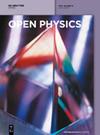Effectiveness of microwave ablation using two simultaneous antennas for liver malignancy treatment
IF 1.8
4区 物理与天体物理
Q2 PHYSICS, MULTIDISCIPLINARY
引用次数: 0
Abstract
Microwave ablation is becoming an increasingly important minimally invasive procedure that uses dielectric hysteresis to generate heat and destroy cancer cells. Tissue damage depends on the input power, procedure duration, and antenna position. Therefore, one of the essential problems is determining parameters that ensure the destruction of the tumor with the desired margins and minimal damage to the healthy tissue. In addition to experimental methods, computer modeling has been proven to be an effective approach for improving the performance of microwave ablation (MWA). Moreover, since the thermal spread in biological tissue is difficult to measure, the development of a predictive model from procedural planning to execution may have a great impact on patient care. This study focuses on determining the optimal parameters for MWA treatment of liver tumors using two identical parallel-positioned multi-slot coaxial antennas. The simulation results suggest that an input power of 20 W or 15 W per antenna suffices for complete tumor ablation with a sufficient safety margin for 600 and 900 s, respectively. In both cases, the created ablation zones were similar. The ablation zones for 15 W per antenna were more spherical, invading a smaller amount of healthy tissue than those for 20 W per antenna. This study may represent a step forward in planning MWA treatment for individual patients.使用双天线同时进行微波消融治疗肝脏恶性肿瘤的效果
微波消融正成为一种日益重要的微创手术,它利用介电滞回产生热量并摧毁癌细胞。组织损伤取决于输入功率、手术持续时间和天线位置。因此,关键问题之一是确定参数,以确保以理想的边缘摧毁肿瘤,并将对健康组织的损害降至最低。除实验方法外,计算机建模已被证明是提高微波消融(MWA)性能的有效方法。此外,由于生物组织中的热扩散很难测量,因此开发一个从程序规划到执行的预测模型可能会对患者护理产生重大影响。本研究的重点是确定使用两个相同的平行定位多槽同轴天线进行肝脏肿瘤 MWA 治疗的最佳参数。模拟结果表明,每根天线的输入功率分别为 20 W 或 15 W,就足以在 600 秒和 900 秒内完全消融肿瘤,并留有足够的安全余量。在这两种情况下,产生的消融区相似。与每根天线 20 瓦的消融区相比,每根天线 15 瓦的消融区更加球形,侵入的健康组织更少。这项研究为规划针对个别患者的 MWA 治疗向前迈进了一步。
本文章由计算机程序翻译,如有差异,请以英文原文为准。
求助全文
约1分钟内获得全文
求助全文
来源期刊

Open Physics
PHYSICS, MULTIDISCIPLINARY-
CiteScore
3.20
自引率
5.30%
发文量
82
审稿时长
18 weeks
期刊介绍:
Open Physics is a peer-reviewed, open access, electronic journal devoted to the publication of fundamental research results in all fields of physics. The journal provides the readers with free, instant, and permanent access to all content worldwide; and the authors with extensive promotion of published articles, long-time preservation, language-correction services, no space constraints and immediate publication. Our standard policy requires each paper to be reviewed by at least two Referees and the peer-review process is single-blind.
 求助内容:
求助内容: 应助结果提醒方式:
应助结果提醒方式:


